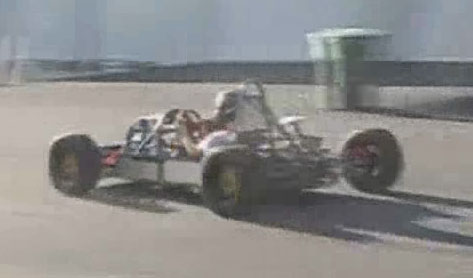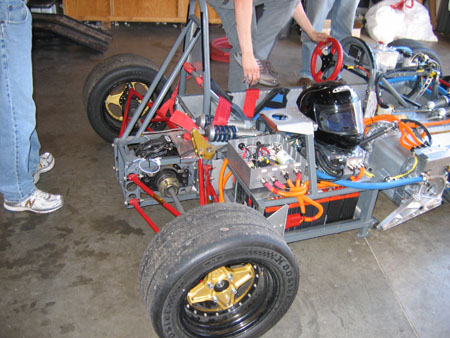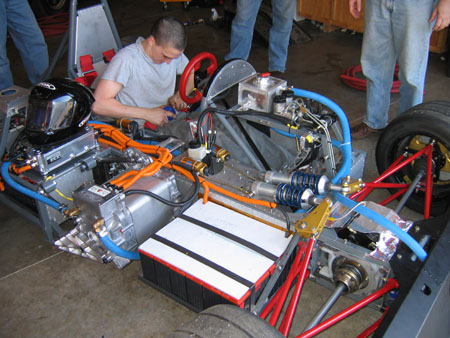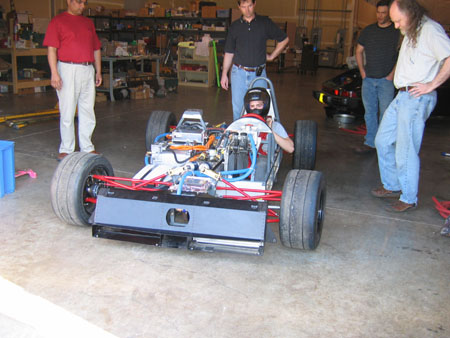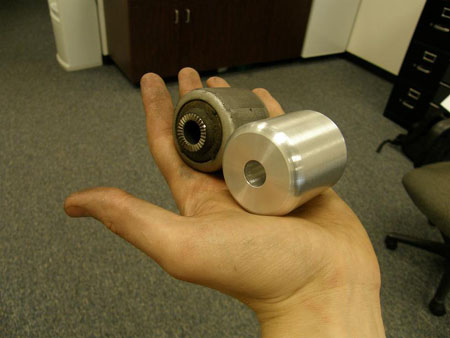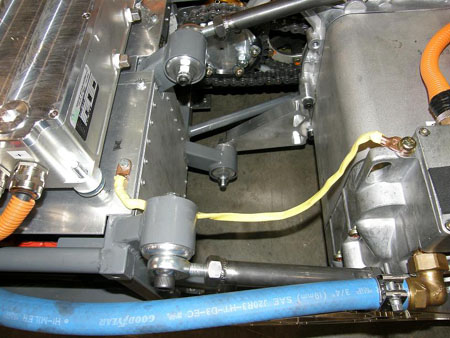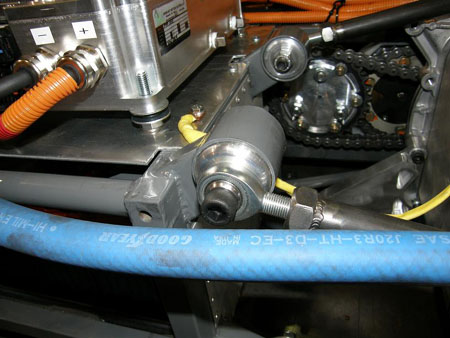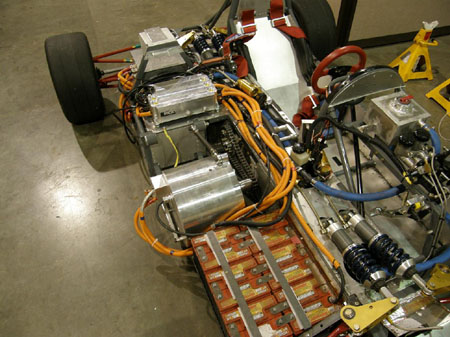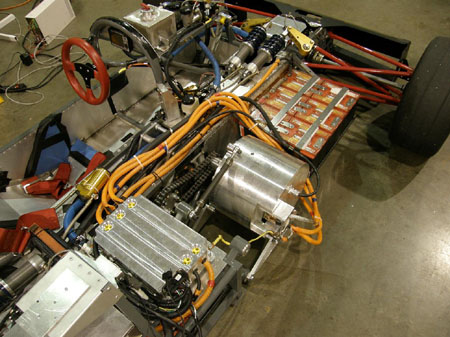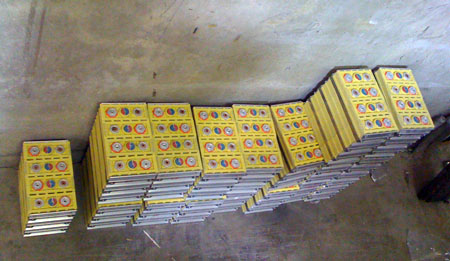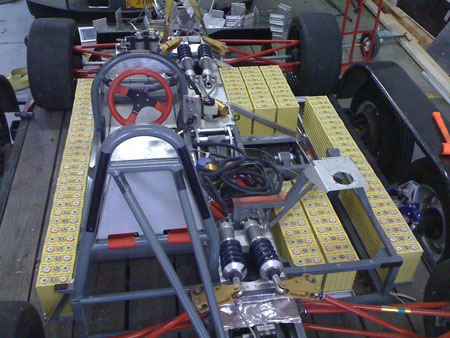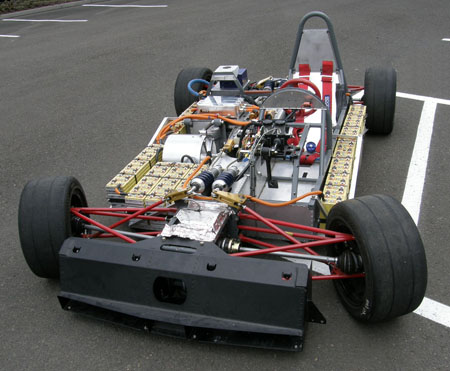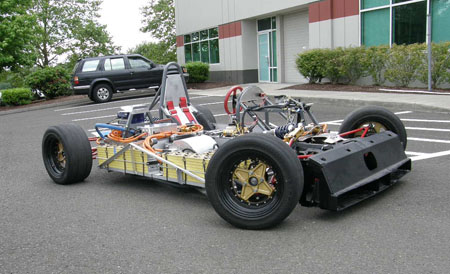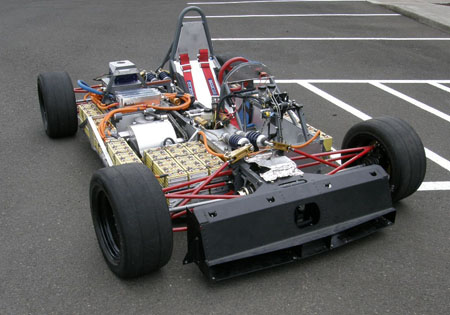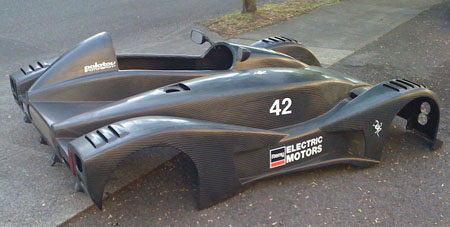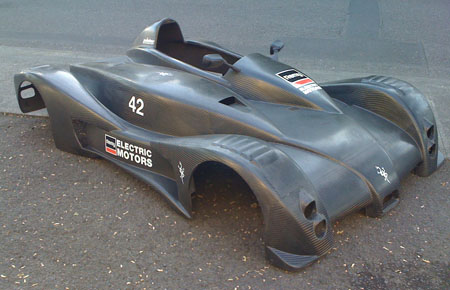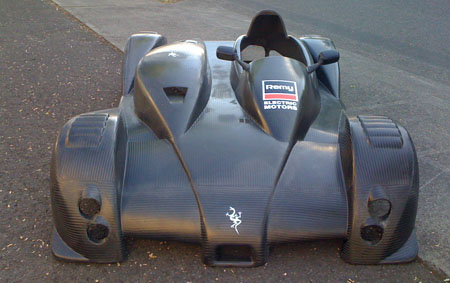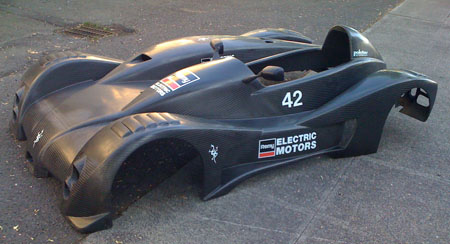|
07/22/09 Yesterday the dp1/e drove under electric power for the first time, a little less than 3 years after the prototype's first drive in gas-powered form. Now it is born again :) A short video documents the occasion. First drives are fun! Congratulations to everyone at RMS on bringing it to life.
07/31/09 So far the controller has been set at a 40% torque limit (100 NM) and 150A. Even with that the car is entertaining, as this onboard video of running around a parking lot shows (no it's not me driving :). So now it's time to up the ante. The torque is up to 160 NM and current is up to 300A. This has necessitated replacing rubber motor mounts with solid aluminum ones, to avoid throwing the primary chain off.
Apparently the car is now too fast for the parking lot (this coming from the guy who drove it in the video) so we'll have to try and set up some testing at Pat's Acres. Battery pack is really marginal for this of course so we only expect a handful of laps but it's better than nothing and will give us some valuable data. Anyone interested in having their advanced battery tested? Let me know. 08/02/09 A few people have asked about the weight of the car so last week I put it on the scales.
This is with 24 Odyssey PC680 batteries. With me in the driver's seat the weight balance is not bad, about 54% right / 46% left. A lighter battery pack would even things out more. This one is 380 lbs of lead. When the current and torque limits are cranked up to full capacity of the controller the car will have about 130 hp so it should be pretty fun. 10/30/09 A week ago we tested the dp1/e at the kart track, along with the dp4. So far this car has been primarily a development test bed for the 100KW RMS controller. It has served the purpose well allowing the fine-tuning of drivability and overall control algorithms. The controller determines the feel of the vehicle because it is the link between the driver and the power that is delivered to the wheels. There is a lot more to these algorithms than one might think and the difference can be between a car that's jerky, unresponsive and annoying to drive and one that responds linearly, predictably and is generally fun. All that development has been largely completed, this test was to try a couple max-output laps. Of course our battery pack is pretty much dead (now below 20% original capacity) so we knew we had literally a lap or two before we'd be out of juice. Below are the speed and battery voltage plots from the initial two laps. The second lap looks like it's about 47 sec which is a bit slower but roughly comparable to the dp4 (have to take into account the number of laps and how hard each car was pushed which is not very). The acceleration onto the front straight (starting at 80 sec mark) is particularly telling of how bad the battery really is, dropping from 315V unloaded to 230V under load. The car can accelerate a good deal better than this but that's all the battery would let us have. The two laps consumed approximately 0.6KWh of energy at which point the pack was 2/3 done - notice how towards the end the voltage drops to 190V under load. When new it should be 2.5-4.5KWh depending on how you measure it (rate of discharge is a very big factor in capacity). So on a brand-new pack of this type we could hope for 6-7 good laps instead of what's really 1-1.5 laps right now (which correlates with other EV testing I've done here). Keep in mind that this is on a 1/2 mile kart track with an average speed of about 30 mph so it puts the real-world challenge of electric race cars in perspective. As another data point, our current battery was used for about 1,200 miles of street driving before being installed in the dp1/e so that is an indication of the kind of life one could expect. The cost of the battery is around $2K so it works out to roughly $2/mile. We are now in discussions about testing an advanced Lithium-based battery of about 10KWh at 300V. That will make it a much more useful (and much faster) car and allow some higher-speed testing. In the meantime, there is a new synchronous DC (brushless) motor that RMS will be testing in the car. It is a good deal lighter than the Ford/Siemens unit and has higher torque so this should be fun. This is definitely a much more interesting life for the chassis than hanging it on a wall like I initially intended :) 11/19/09 The work on dp1/e continues. RMS now have a permanent magnet motor mounted and running. It puts out 330 NM (about 245 lb-ft) which is more than double that of the Ford AC unit.
Size and weight are comparable to the Ford (the prototype motor enclosure is a good deal larger than it needs to be). We should have some video of it driving around shortly. Still stuck with the dead battery pack for now, hopefully that will change soon. 05/27/10 So far the dp1/e has served as the development and demo car for the RMS controller and a testbed for a couple different motors. Now we're contemplating a somewhat more public role for it - a trip to Laguna Seca for the Refuel Time Trial in July. It's not fully confirmed yet but it's the goal. We've needed to put a real battery in the car for quite some time, so now we might actually get around to doing it. Karl drove it briefly around the RMS parking lot and declared that he would have a blast at Laguna. I think I would too :) So we'll work on making that happen.
06/13/10 A number of news bits for this car. First, we can finally announce that the test motor we've been running in it is made by Remy and that we'll be doing a lot more with it soon besides this experimental installation. It's a permanent-magnet machine of roughly 80KW with 3-phase drive courtesy of RMS and a very compact design with excellent power density. The test housing doesn't do it justice (the housing literally weighs as much as the motor even though it can be 1/4 that). I'm in the process of developing an integrated housing that combines the motor and the drive controller and it will eventually be marketed by Palatov Motorsport. Should be ready in a couple months. Another bit of news that's long overdue - we finally have a new battery pack for the dp1/e. It is quite different from the old one.
The original pack consisted of 24 hand-me-down Odyssey lead-acid batteries. Combined they weighed 400 lbs, provided around 3KWh at 288V (in their prime at least) and cost just short of $3K. The new pack is 110 of 40Ah LiFePO4 cells. The weight is almost exactly the same, voltage is around 360V, physical space is about double, storage capacity is 4.5X and cost is roughly double that of the old pack as well. Not bad, all in all. The challenge now is finding room for all of it but I think I have it figured out. Tristan will be making the appropriate bits and pieces next week. Of course tradeoffs remain. These cells are rated for 3C continuous current so that's about 120A, which is less than half of what the motor needs to produce max power. There are several choices. One is to go with same number of larger cells - but cost, wieght and size grow beyond practical for this particular application. Or we could go with smaller number of larger cells and while that addresses size and cost, the voltage now falls short and we're back to less than full power. Another possibility is to use fancier cells which can tolerate greater current. There are some cylindrical cells that will do double continuous current but they cost twice as much, all else being rougly equal. Or we could use super cells that are both smaller and more powerful but the cost is now 6X. Great for F1 KERS (on which the RMS controller is directly based) but not so good here. So we are left with the final alternative - manage the battery according to situation. We'll have a dial that goes 1-11, with 1 being the most conservative half-power setting, 10 being very aggressive and possibly cell-life-shortening but still sane and 11... well, should be obvious. We won't use that one much but it'll be there. Now of course not much is known about the condition of the cells we got and having heard stories of DOA batteries I remain cautious until we've done some testing. But it's got to be better than long-dead lead acids - no mystery about the condition of those. So I don't know if we'll have a fast car yet but I do know we'll have a more usable car than before and that will enable us to do some good things. Stay tuned. 06/22/10 We have less than a week to go before our next track event on the 28th and we are frantically working to get the dp4 and dp1/e ready. The dp4 is completely apart and the frame is still at the powdercoaters - it was supposed to be back today but they've encountered some kind of equipment problem. Things are running behind on the dp1/e also, but at least we've got the basic framework for the battery pack welded up and the pack test-fitted (there are 5 additional batteries that go behind the right front wheel). This is roughly 14KWh or just under half a gallon of gas :)
Still needs a lot of reiforcement and various systems fitted. The BMS won't be ready for Monday but we can do some stuff without it. Challenges abound but we're making progress. 07/02/10 After a couple delays and lots of work both here and at RMS it looks like we'll make it to Laguna afterall. RMS just finished installing the motor, controller, plumbing, wiring and a few other bits, as well as putting the initial charge in the pack. Kyle said "Well it's properly fast now. The old batteries were holding it back quite a bit. It's ready for Monday morning". Monday is when we go to test at Pats Acres kart track. More then.
07/05/10 A good test at Pat's Acres. The car ran well and is quite fast with lap times not too far off those of the dp4. Of course this is a very tight course and neither car is fully sorted yet, but the dp1/e is a fun machine to drive! :) Here's a video: The car is back at RMS for some software tweaks and if we're lucky the new motor housing from Remy will show up tomorrow so we can install it. The motor is a LOT smaller than the test housing makes it look. The test piece was hurriedly made for a stationary rig and weighs about 65 lbs, whereas it only needs to be 10-15 lbs or so. The bodywork will get installed Wednesday morning most likely.
We won't get a chance to do any high-speed testing before we leave for Laguna Wednesday, so the race will be the test. This is all one big experiment. Should be interesting.
|
